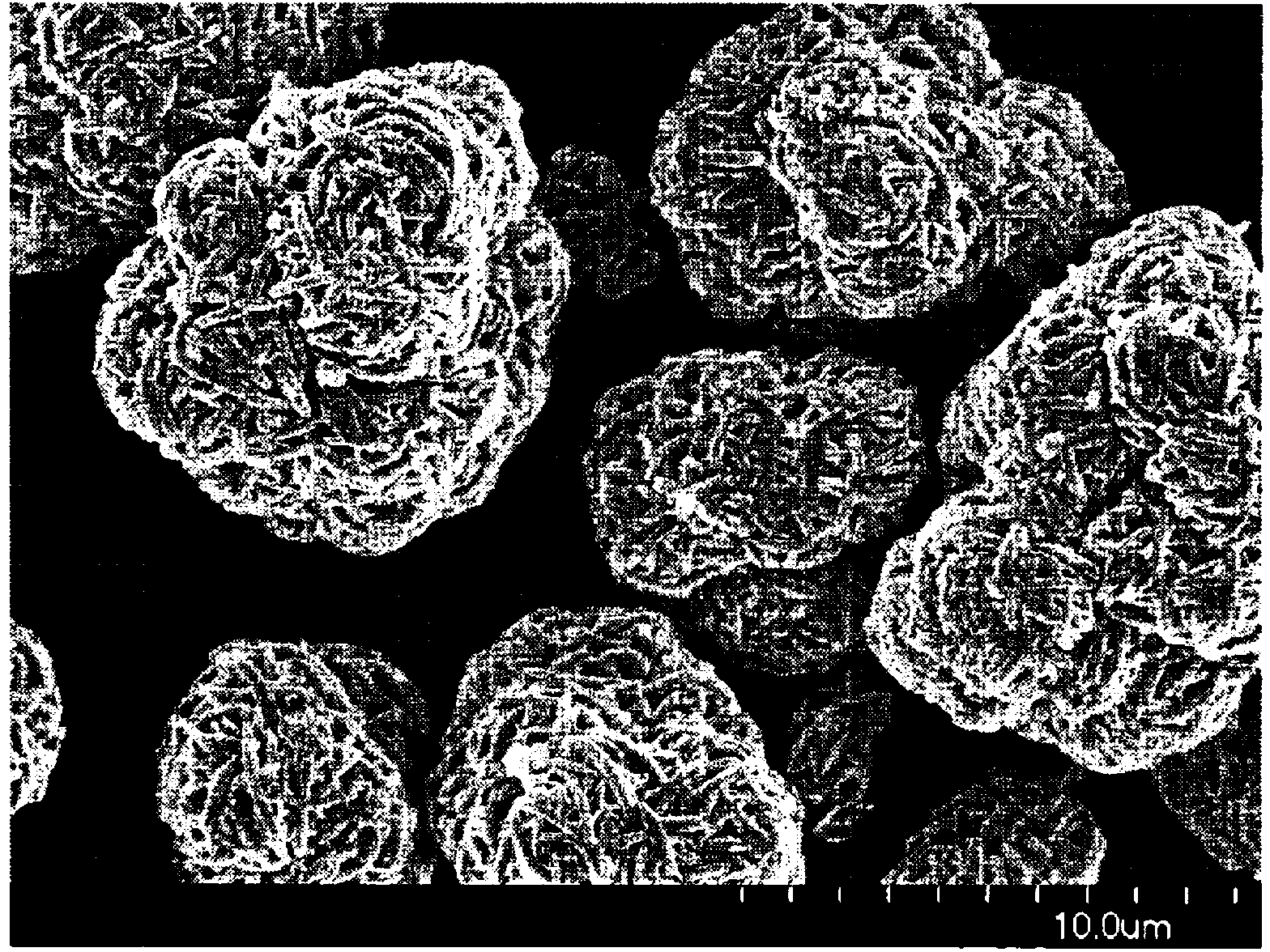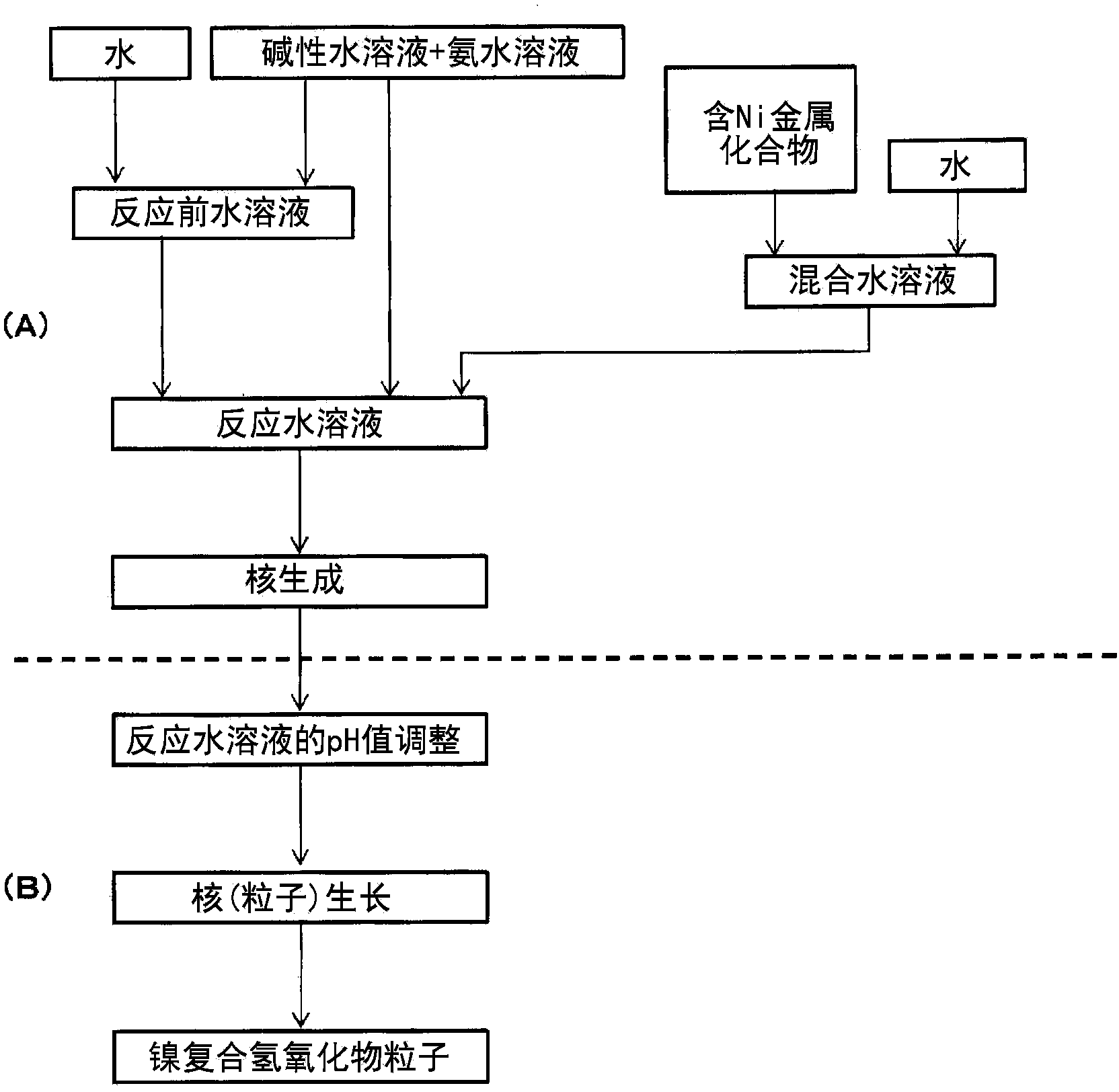Nickel composite hydroxide and process for producing same, positive active material for nonaqueous-electrolyte secondary battery and process for producing same, and nonaqueous-electrolyte secondary battery
A composite hydroxide and positive active material technology, applied in non-aqueous electrolyte batteries, active material electrodes, secondary batteries, etc., can solve the problems of undeveloped particle size uniformity, particle deterioration, battery capacity reduction, etc. Suitable for mass production, high industrial value effect
- Summary
- Abstract
- Description
- Claims
- Application Information
AI Technical Summary
Problems solved by technology
Method used
Image
Examples
Embodiment 1)
[0296] [Manufacture of nickel composite hydroxide]
[0297] (nucleation process)
[0298] Add 7.2 L of water to a baffled reaction tank with a capacity of 50 L capable of maintaining the environment in the tank, and flow nitrogen gas while stirring at 500 rpm with an inclined paddle-type stirring blade, thereby reducing the oxygen concentration in the environment in the reaction tank to below 1% by volume, and adjust the temperature in the tank to 40°C. Add an appropriate amount of 25% by mass sodium hydroxide aqueous solution and 25% by mass ammonia water to the reaction tank, adjust the pH value of the reaction solution in the tank under the liquid temperature standard of 25°C to 12.6 and adjust the ammonia concentration to 10g / L, thus forming a reaction pre-water solution.
[0299] Next, 35 mL of a 1.9 mol / L mixed aqueous solution obtained by dissolving nickel sulfate and manganese sulfate (the molar ratio of metal elements being Ni:Mn=50:50) in water was added, and the r...
Embodiment 2)
[0325] In the composite hydroxide manufacturing process, in addition to nickel sulfate and manganese sulfate, sodium tungstate is also dissolved in water to form a mixed aqueous solution, except that it is operated in the same manner as in Example 1 to obtain a non-aqueous electrolyte secondary battery A positive electrode active material was used and evaluated. In addition, in this mixed aqueous solution, the molar ratio of each metal element was adjusted to Ni:Mn:W=49.75:49.75:0.5. The composition of the obtained composite hydroxide is Ni 0.4975 mn 0.4975 W 0.005 (OH) 2+a (0≤a≤0.5). In addition, the composition of the obtained positive electrode active material is Li 1.20 Ni 0.4975 mn 0.4975 W 0.005 o 2 , It was confirmed by powder X-ray diffraction that it is composed of a single phase of hexagonal layered crystal lithium-nickel-manganese composite oxide.
Embodiment 3)
[0327] In the composite hydroxide production process, in addition to nickel sulfate and manganese sulfate, zirconium sulfate was also dissolved in water to form a mixed aqueous solution, except that it was performed in the same manner as in Example 1 to obtain a non-aqueous electrolyte secondary battery. A positive electrode active material was used and evaluated. In addition, in this mixed aqueous solution, the molar ratio of each metal element was adjusted to Ni:Mn:Zr=49.75:49.75:0.5. The composition of the obtained hydroxide is Ni 0.4975 mn 0.4975 Zr 0.005 (OH) 2+a (0≤a≤0.5). In addition, the composition of the obtained positive electrode active material is Li 1.20 Ni 0.4975 mn 0.4975 Zr 0.005 o 2 , It was confirmed by powder X-ray diffraction that it is composed of a single phase of hexagonal layered crystal lithium-nickel-manganese composite oxide.
PUM
| Property | Measurement | Unit |
|---|---|---|
| particle size | aaaaa | aaaaa |
| particle size | aaaaa | aaaaa |
| particle size | aaaaa | aaaaa |
Abstract
Description
Claims
Application Information
 Login to View More
Login to View More - R&D
- Intellectual Property
- Life Sciences
- Materials
- Tech Scout
- Unparalleled Data Quality
- Higher Quality Content
- 60% Fewer Hallucinations
Browse by: Latest US Patents, China's latest patents, Technical Efficacy Thesaurus, Application Domain, Technology Topic, Popular Technical Reports.
© 2025 PatSnap. All rights reserved.Legal|Privacy policy|Modern Slavery Act Transparency Statement|Sitemap|About US| Contact US: help@patsnap.com



